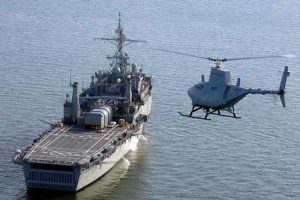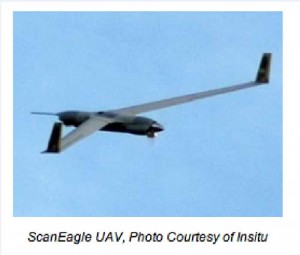Unmanned Aircraft Systems (UAS) and the Future of the Amphibious Force
By Vince Martinez
Vince Martinez is a regular contributor to Second Line of Defense and is the President and Founder of Affinity Fidelis Consulting and Technologies; a defense consulting firm in Northern Virginia.
***
10/29/2010 – As the military complex churns at a break-neck pace to develop the next generation of unmanned systems, key questions loom as to how these systems will evolve into relevant roles across a myriad of applicable mission sets and operational scenarios.
Although interesting, unmanned systems by themselves do not create desired effects. Only when such systems are blended into an effective concept of operations will they become useful tools to the warfighter or the global security team.
Although interesting, unmanned systems by themselves do not create desired effects. Only when such systems are blended into an effective concept of operations will they become useful tools to the warfighter or the global security team.
Unmanned aircraft systems (UAS) have found niches across the strategic, operational, and tactical landscapes of all services. The operational characteristics being considered for future unmanned platforms cross many of the boundaries of manned aircraft mission sets of today – like transportation of troops and supplies, air-to-air interdiction, close air support (CAS), and command and control.

However, one of the most significant challenges associated with these emerging unmanned capabilities – specifically for the Navy – is in defining methods for co-existence and interoperability with current and future Naval capabilities. Compared to other inherent Naval capabilities, the operational value of unmanned systems must be evaluated in terms of their ability to operate off of ships.
For example, the unmanned systems have to be managed aboard ships with their corresponding logistics footprint, having aboard the manpower required to maintain and operate the systems, and able to operate with the operational tempo required to sustain shipboard operations during naval and amphibious operations.
Looking at other emerging capabilities, the Marines are fielding platforms like the MV-22, the F-35, the AH-1Z, the UH-1Y, and the CH-53K which each bring significant operational enhancements over their legacy counterparts.
The key question, then, is what role will UAS play in the future when balanced against the roles and missions of the platforms mentioned above, and what is the logistics offset required to balance the capabilities?
As evidenced by the MV-22’s introduction, along with the exponential capability enhancement of a technologically complex aircraft comes an increase in overall weight, footprint, and stowage. With a corresponding increase in cube and square for ground systems like the Joint Light Tactical Vehicle (JLTV) and the Medium Tactical Vehicle Replacement (MTVR), the exponential weight growth of the MAGTF has become an issue that now affects how Amphibious Readiness Groups (ARG) look today, and will be even more critical in defining what it looks like in the future.
Where do evolving unmanned systems fit within such a challenge?
As the Marine Corps aggressively moves toward restoring its amphibious roots, the key question looms around what is the most effective and efficient use of space aboard naval shipping in order to maintain and sustain the desired amphibious operational impact.
Other operational questions will arise as well. When looking at the Aviation Command Element (ACE), as an example, with the anticipated increase in sortie requirements associated with platforms like the F-35s, how will ship-based UAS platforms fit into deck cycles and established operational flows with the other platforms while conducting air operations? What, then, is the relative value of launching and recovering ship-based UAS platforms when compared against the MV-22 for transportation of troops and supplies, or the UH-1Y for command and control?
An MV-22B Osprey assigned to Marine Medium Tiltrotor Squadron (VMM) 162 prepares to take off from the amphibious assault ship USS Nassau (LHA 4). Nassau is the command platform for the Nassau Amphibious Ready Group supporting maritime security operations and theater security cooperation operations in the U.S. 5th Fleet area of responsibility. (Credit photo: USN Visual Service)
Many of the greatest operational challenges for the ACE revolve around the management of deck cycles and how that supports the overall amphibious operation or ground scheme of maneuver. With ship-based UAS platforms those challenges will only grow more complex.
What will be the UAS demand be on deck cycle, airspace de-confliction, and command and control in order to support ship-based operations? How will all of the factors of storing, maintaining, and operating UAS platforms aboard naval shipping compare to manned platforms, which in turn raises the question of the system’s relative operational impact?

Clearly, there is a significant role for UAS in the current and future MAGTF for the Marine Corps. The UAS platforms are definitely here to stay. Their variety is significant and the roles vary from battalion-level Small Unmanned Aerial Systems (SUAS), like the Raven B, to the shipboard capable Small Tactical UAS (STUAS) that is expected to operate off of ships around 2013; not to mention the larger UAS platforms like the Shadow and other land-based unmanned aircraft assets anticipated to come into use around 2016-2025.
With budget constraints that extend across all services, however, and with the litany of challenges that exist today in defining strategies for designing, funding and fielding naval vessels that can accommodate future aviation platforms, the challenge will remain to find the right operational balance. For UAS, this means shaping its roles with a brood of very capable manned platforms that are fighting for space aboard navy ships right alongside them.
The Navy has to ask some very tough questions of all their aviation platforms as they look toward the future – UAS included. The services need to determine what embarkation strategies are the best, not only the MAGTF, but for the naval force as a whole. Such a calculation must include answering hard questions about a given system’s footprint versus its operational impact.
With budget constraints that extend across all services, however, and with the litany of challenges that exist today in defining strategies for designing, funding and fielding naval vessels that can accommodate future aviation platforms, the challenge will remain to find the right operational balance. For UAS, this means shaping its roles with a brood of very capable manned platforms that are fighting for space aboard navy ships right alongside them.

